Out of the Spotlight
Back to Contents of Issue: December 2002
|
|
|
|
by Michael Stanley |
|
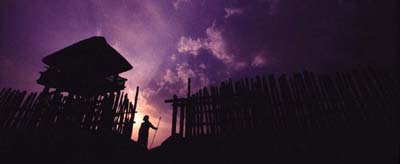 RECENTLY THE ANACHRONISTIC AND Byzantine system of Japanese public-works spending has come under justifiably severe criticism. In last month's issue of J@pan Inc, we took a look at the matrix of ecological catastrophes developing as the climax to a half-century pork-barrel boondoggle in Nagasaki Prefecture's Isahaya Bay. That example of the corporate-cum-political-cum-bureaucratic incest has spawned a whole brood of problems that are just beginning to rear their ugly heads. Looking at that serpents' nest, one is left to ask what good such a system could have produced. This month, in the second installment of our occasional series on public works, Michael Stanley answers that question. RECENTLY THE ANACHRONISTIC AND Byzantine system of Japanese public-works spending has come under justifiably severe criticism. In last month's issue of J@pan Inc, we took a look at the matrix of ecological catastrophes developing as the climax to a half-century pork-barrel boondoggle in Nagasaki Prefecture's Isahaya Bay. That example of the corporate-cum-political-cum-bureaucratic incest has spawned a whole brood of problems that are just beginning to rear their ugly heads. Looking at that serpents' nest, one is left to ask what good such a system could have produced. This month, in the second installment of our occasional series on public works, Michael Stanley answers that question.IT IS ALL TOO easy to jump on the anti-public-works bandwagon. The tune of doom and gloom is an easy one to master and it does grab the public ear. However, a little devil's advocacy may be called for here: while the excesses of Japan's construction addiction are indeed obvious, the nation has nevertheless benefited from the amazing advances in its physical infrastructure over the last half-century. Moreover, reasonable public-works spending in the right direction may at some point become a catalyst for consumer spending, the low level of which is an obvious millstone around the neck of the Japanese economy. In the long run, the eventual evolution of seriously responsible management and direction of public-works projects and their financing may be far more important than any real reduction in the amount spent on them. The real source of the difficulty is the Japanese cultural tendency toward a tribalistic miuchi ishiki (literally "kinship feeling"), a term that sounds innocent enough at first, but in Japanese has nuances of a negative, narrow-minded clannishness. Organizations -- corporations, government ministries, and industry associations, for instance -- seem unable to perceive anything not directly concerned with their own immediate and vested self-interest. A clear and classic historical example was the inability of the Japanese Imperial Army and Navy to effectively work together even as the Allies carried the Pacific War to the heart of the Japanese homeland. Even the threat of imminent catastrophe could not budge them from their petrified thinking. Japan's real, functioning organizational philosophy has not materially changed in the succeeding six decades, and that is the core of the problem. The spending excesses and scandals are the symptoms of this underlying illness, not the causes. 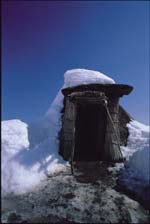 During my travels on assignment to various parts of Japan, I have had ample opportunity to view some of the results of Japan's construction mania. Much of it has been amazingly overdone and out of place, but some has been evidently useful. I thoroughly enjoyed using some of the newer elements of the highway network, for example. While it is true that apparently pointless roads that lead nowhere do get built, the improvement of much of Japan's skein of intercity highways and rural roads over the last two decades has been nothing short of miraculous. I remember all too well the infuriatingly bad design, short-sighted engineering and -- last, but certainly not least -- the effectively meaningless signage that virtually guaranteed long sessions with a map at roadside rest areas or in restaurant parking lots.
During my travels on assignment to various parts of Japan, I have had ample opportunity to view some of the results of Japan's construction mania. Much of it has been amazingly overdone and out of place, but some has been evidently useful. I thoroughly enjoyed using some of the newer elements of the highway network, for example. While it is true that apparently pointless roads that lead nowhere do get built, the improvement of much of Japan's skein of intercity highways and rural roads over the last two decades has been nothing short of miraculous. I remember all too well the infuriatingly bad design, short-sighted engineering and -- last, but certainly not least -- the effectively meaningless signage that virtually guaranteed long sessions with a map at roadside rest areas or in restaurant parking lots.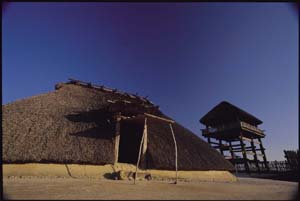 However, there was another unexpected aspect of Japan's love for publicly funded construction that I got to know as I traveled through the country working on a series of projects centered on Japan's archaeology and cultural evolution. These assignments required photography of modern reconstructions of ancient structures from various periods of the archipelago's history. And -- I'm sure you've jumped ahead and guessed it --these modern reconstructions were all publicly funded in one way or another. Moreover, in every case, the managing officials were extremely keen to cooperate with my research and often were decidedly active in suggesting possibilities for interesting photographs. Some even bent the rules in a big way. They were light years away from the legendary bureaucratic trolls that are said to shrink from the light and noise of dealing with the public in general and the media in particular.
However, there was another unexpected aspect of Japan's love for publicly funded construction that I got to know as I traveled through the country working on a series of projects centered on Japan's archaeology and cultural evolution. These assignments required photography of modern reconstructions of ancient structures from various periods of the archipelago's history. And -- I'm sure you've jumped ahead and guessed it --these modern reconstructions were all publicly funded in one way or another. Moreover, in every case, the managing officials were extremely keen to cooperate with my research and often were decidedly active in suggesting possibilities for interesting photographs. Some even bent the rules in a big way. They were light years away from the legendary bureaucratic trolls that are said to shrink from the light and noise of dealing with the public in general and the media in particular.It is significant that none of these locations were temples, which are in their own way just as effectively bureaucratic as any governmental organization but nowhere near as cooperative. At the outset, I had hoped for an open-minded attitude conducive to producing articles that would help convey the cultural depth and weight of the Buddhist element in Japanese tradition. But the main thrust in any discussion of photography for publication centered on what sort of fee the monks could extract. Thankfully, dealing with them was rarely necessary, and they did not come to figure in the project. 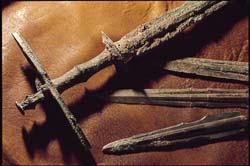 Actually, after coming to Japan, reaching saturation with Buddhist temple architecture to the point of excruciating boredom took almost no time at all. However, even now, a look at many of the guidebooks to Japan leaves a distinct impression that the dark, brooding, tile-roofed temples were Japan's major contribution to the world's architectural heritage and that if you miss the Something-something-Tera here or the Whatsis-Ji there, then you've missed the soul of the nation. I vociferously beg to differ. Perhaps I am too easily jaded, but the monotony of temple architecture is a blurry, chiaroscuro reflection of an imported tradition that is totally uncharacteristic of the amazing variety that is really at the root of Japan's ethnos. It was this variety as expressed in the history of Japanese structures that formed the foundation of the theme of my project and opened the door to an aspect of the modern Japanese addiction to building that I did not expect.
Actually, after coming to Japan, reaching saturation with Buddhist temple architecture to the point of excruciating boredom took almost no time at all. However, even now, a look at many of the guidebooks to Japan leaves a distinct impression that the dark, brooding, tile-roofed temples were Japan's major contribution to the world's architectural heritage and that if you miss the Something-something-Tera here or the Whatsis-Ji there, then you've missed the soul of the nation. I vociferously beg to differ. Perhaps I am too easily jaded, but the monotony of temple architecture is a blurry, chiaroscuro reflection of an imported tradition that is totally uncharacteristic of the amazing variety that is really at the root of Japan's ethnos. It was this variety as expressed in the history of Japanese structures that formed the foundation of the theme of my project and opened the door to an aspect of the modern Japanese addiction to building that I did not expect. Scattered throughout Japan is a variety of archaeological and historical sites that have been reconstructed or restored to some aspect of their original appearance. Usually these sites have a museum attached; some of them are prefectural or national historical parks on their own or parts of larger complexes. Their cost is but a tiny fraction of the huge amounts spent on such things as reclamation and road-building. For example, the total fiscal 2002 (April-March) national budget for preservation and restoration of historical sites is JPY2.69 billion, a mere fraction of the total cost for the Isahaya Bay project, which is JPY235 billion and climbing as of this writing. Sadly, in many cases, the results of these projects are not well known outside of their immediate area. But some are indeed impressive, conveying a concrete, three-dimensional sense of presence for various eras of Japanese history and prehistory. If properly managed, the cultural and educational value of these sites may just be well worth what was spent on their research, design and construction. These smaller efforts have had a positive impact. Despite the problems that some may have, they are, in the last analysis, a plus on the side of public works in this country. I have chosen a few of these sites as samples. 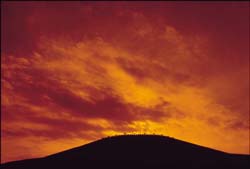
Aomori's Sannai Maruyama A little background on these sites is in order. None of the sites mentioned hereafter dates to the Paleolithic era -- the classic Old Stone Age. The oldest site I will mention here is that of Sannai Maruyama, near Hirosaki in Aomori Prefecture. It is from what the Japanese call the Jomon Period, an era that extended from about 10,000 years ago to about 300 years B.C.E. ("Before the Common Era," a term a bit more universal than the old "Before Christ" B.C.). The site at Sannai Maruyama was evidently inhabited between 5,500 and 4,000 years ago. "Jomon" means "cord-marked" and was originally used to describe a particular ceramic tradition; it has now become a catchall for the complex of apparently indigenous cultures that developed in the main Japanese islands during that long span of time. The subsistence of most Jomon cultures was heretofore thought to have been based solely on seasonal foraging, not on agriculture or husbandry, although some small-scale rice-growing did develop as the era drew to a close. However, evidence has been found at Sannai Maruyama of the cultivation of chestnut groves, gourds and burdock. Of course traditional foraging was certainly a part of the subsistence, but additional evidence hints at deep-sea fishing, a pursuit that requires a well-developed technological base. Until recently, foraging and mixed-subsistence cultures were considered more primitive than fully agricultural ones, but evidence from cultural areas such as the Japanese archipelago and the Northwest Coast of North America has shown that such societies, when blessed with a rich enough environment, have grown as complex as many settled agricultural ones. Authorities generally agree that the earliest ceramics in the world were produced in Japan by Jomon artisans almost 10,000 years ago. The recovered human remains from the Jomon cultures indicate that the people were of a physical type similar to the modern Ainu; this, coupled with the occurrence throughout Japan of place-names of clearly Ainu-language origin, easily prompts speculation that some if not all of the Jomon cultures spoke an Ainu or Ainu-related language. While local inhabitants knew of pottery shards and such from the site, it wasn't until construction of a baseball stadium turned up a rich trove of relics that scientific excavation of the site got underway in 1992. It turned out to be the largest and most complex Jomon Period site ever discovered, and quickly drew the nation's attention. At the same time, two chronically irritating aspects of the popular Japanese treatment of archaeological or historical discoveries came to the fore: The first is the tendency to essentially Ôdumb down' a site and turn it into nothing more than a tourist attraction with plenty of room for little emporiums to hawk gewgaws; the second is the chronic tendency for writers and commentators of a nationalistic bent to hijack the cultural significance of the site and essentially churn out tasteless inflated books and articles that boil down to yet another take on the theme of "we Japanese vs. everybody else." These two aspects crop up again and again across the board. At Sannai Maruyama, a measure of common sense did appear to triumph eventually. The reconstruction of some of the site's structures began in 1995, using funding from the municipal park budget. In most cases like this one, funding is shared on a 50-50 basis between the national and local governments. On the national side, the Ministry of Land, Infrastructure and Transport and the Ministry of Education, Culture, Sports, Science and Technology were the major funding sources. Often, projects are chopped up between them, and it gets very difficult to tell how the funding is divided. The budgets are normally drawn up on a year-by-year basis. Although long-term projects can have rough figures allocated, they are liable to change suddenly on a yearly basis. Even with this potential instability, research excavations continue, with 620 full-time personnel involved at Sannai Maruyama. Despite some scholar vs. scholar contention on the accuracy of some parts of the restoration, the site is indeed impressive and it is a magnet for school tour groups. 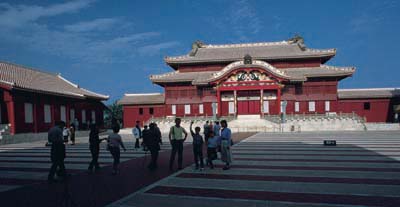 Kyushu's Yoshinogari
Kyushu's YoshinogariThe site of Yoshinogari in Kyushu's Saga Prefecture made headlines throughout Japan when excavation was begun in 1989. Three years earlier, preliminary work on a proposed industrial park turned up evidence of a major settlement from the Japanese cultural era called the Yayoi, which followed the Jomon cultures in most of Japan and lasted for about 600 years beginning about 300 B.C.E. Yayoi period remains are far from rare, especially in Kyushu, but what riveted the attention of the nation to this site was the discovery of the traces of large buildings, a palisade and watchtowers. All these essentially matched a description in a 3rd Century Chinese chronicle describing the proto-state of Yamatai in the islands of Wa, as the Japanese archipelago was then known. The impact was essentially the same as might be felt in the English-speaking world if the ruins of a medieval castle with a huge round table matching that of Arthur's Camelot were to be found under some English moor. The similarity to the ancient description of Yamatai -- the location of which was and still remains a mystery -- gave rise to fevered media speculation that the ancient state's capital had been found. Most scholars now discount the possibility; while Yoshinogari was evidently of some importance, its size and age seem inappropriate for the Yamatai accolade. Nevertheless, Yoshinogari has been developed into a large facility that is amazing and impressive. What is a pity is that sites such as Yoshinogari and Sannai Maruyama are very little known to non-Japanese and that very little effort is made to attract foreign visitors or to publish useful guides or introductions in any language other than Japanese. The overall Japanese attitude seems to be that Japanese archaeology is for Japanese only, despite efforts by a handful of researchers to publish internationally. This closed-mindedness plays very well into the hands of the writers of nationalist bent and further clouds understanding of the fact that Japan was not, and is not, some cul-de-sac at Asia's farther end, but a crossroads. Popular interest in Yoshinogari fueled a project to develop the site into a large-scale historical park, and the major parts of the reconstruction have been recently completed. The photographs are of the first section completed in the 1990s. Kobe's Goshikizuka Kofun At the other end of the scale, a site from the Kofun (Tumulus) Period of the 4th through 7th Centuries typifies many of the smaller sites. The Goshikizuka Kofun was reconstructed in a suburb of Kobe in the late 1960s and early 70s and is a splendid example of what a local ruler's tomb may have looked like in the 6th or 7th Century, just as Yamato -- Japan-to-be -- was emerging as a true state. The tumulus, or ancient grave mound, is now in the middle of an urbanized area, but its restoration has been carefully maintained. It is indeed a surprise to come upon this restoration in the middle of the city; in fact, I first found out about it in a tongue-in-cheek book titled 100 Views of Japan's Scenery That No One Goes to See. With a bit of imagination, however, the visitor can see in his mind's eye the great keyhole-shaped mound as a site for ancient ceremonies overlooking the Inland Sea and Awaji Island. The total cost of the reconstruction (JPY252 million) was divided between the Ministry of Education (50 percent), Hyogo Prefecture (25 percent) and the city of Kobe (25 percent), but the city of Kobe now covers the entire yearly maintenance cost of JPY7 million. This pattern of cost-sharing appears to be typical; the jockeying by smaller, local construction firms for such contracts is easy to imagine. However, the vulnerability enforced by the year-by-year budgeting can have an unsettling effect. Kiyohide Higashi of the Cultural Properties Division of Kobe's Education Board put it this way: "We were expecting...the building of a museum as an annex to the site, but everything got put on hold after the 1995 Hanshin Earthquake. We are applying for a budget every year, and every year we get turned down." Castles of Okinawa and Shizuoka My last two examples are two historical castles that were roughly contemporaneous. Both were reconstructed using traditional methods, with no poured concrete battlements and concealed service elevators. The larger and more famous of the two is Okinawa's Shuri Castle, home to the kings of the Ryukyu Kingdom from the 15th to the 19th Century. Shuri Castle's restoration, the main part of which was completed in late 1993, was a sign of the re-emergence of Okinawan cultural identity. Funding for the project was shared by the national government and the prefecture, and Shuri Castle was included as part of a national historical park, ensuring a modicum of fiscal health for the project.  One interesting aspect of Shuri Castle's restoration was the use of traditional craftsmen on a large scale. The main upper structures of the Shuri Castles of the past were all of wood, and the occasional fires that burned through them usually resulted in total destruction, causing detailed records to be left of the rebuilding. The last destruction in the 1945 Battle of Okinawa virtually obliterated the castle. The older records provided vital clues for the reconstruction, and those old plans were followed as faithfully as possible by master carpenters and masons. And while traditional Japanese castles have many aspects in common, the design of Shuri Castle seems more Chinese in its roots, meaning that extrapolating design elements from Japanese castles was not an option. In addition, the bright colors of the castle are all traditional lacquer finishes, and craftsmen came from all over Japan to participate in this largest-ever lacquer project. Without the support of a publicly funded project, such living use of traditional crafts would be impossible.
One interesting aspect of Shuri Castle's restoration was the use of traditional craftsmen on a large scale. The main upper structures of the Shuri Castles of the past were all of wood, and the occasional fires that burned through them usually resulted in total destruction, causing detailed records to be left of the rebuilding. The last destruction in the 1945 Battle of Okinawa virtually obliterated the castle. The older records provided vital clues for the reconstruction, and those old plans were followed as faithfully as possible by master carpenters and masons. And while traditional Japanese castles have many aspects in common, the design of Shuri Castle seems more Chinese in its roots, meaning that extrapolating design elements from Japanese castles was not an option. In addition, the bright colors of the castle are all traditional lacquer finishes, and craftsmen came from all over Japan to participate in this largest-ever lacquer project. Without the support of a publicly funded project, such living use of traditional crafts would be impossible.As a contrast, the rebuilding of the small castle of Kakegawa in Shizuoka Prefecture was supported mostly by the local government and a local popular subscription effort. This reconstruction duplicates the castle as it was during the Tokugawa Shogunate (1603-1868). When its keep was completed in 1995, it was the first such traditional Japanese castle structure to be built of wood in the original manner. The castle has added panache to what was formerly just another small city along the Tokaido bullet train line. While the "pave for posterity" philosophy is unfortunately alive and well, Japan's public-works projects have produced some small but positive results that seem to be poorly appreciated. Now the task is to tame that concrete-pouring juggernaut and to direct its energies more skillfully. What is required is a wholesale re-examination of the organizational decision-making process behind public works. The sites that appear here provide a glimmer of hope that there is some common sense out there. @ |
|
Note: The function "email this page" is currently not supported for this page.





